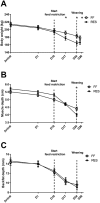Consequences of negative energy balance on follicular development and oocyte quality in primiparous sows†
- PMID: 31504218
- PMCID: PMC7016286
- DOI: 10.1093/biolre/ioz175
Consequences of negative energy balance on follicular development and oocyte quality in primiparous sows†
Abstract
Metabolic demands of modern hybrid sows have increased over the years, which increases the chance that sows enter a substantial negative energy balance (NEB) during lactation. This NEB can influence the development of follicles and oocytes that will give rise to the next litter. To study effects of a lactational NEB on follicular development, we used 36 primiparous sows of which 18 were subjected to feed restriction (3.25 kg/day) and 18 were full-fed (6.5 kg/day) during the last 2 weeks of a 24.1 ± 0.3 day lactation. Feed restriction resulted in a 70% larger lactational body weight loss and 76% higher longissimus dorsi depth loss, but similar amounts of backfat loss compared to the full fed sows. These changes were accompanied by lower plasma insulin-like growth factor 1 (IGF1) and higher plasma creatinine levels in the restricted sows from the last week of lactation onward. Ovaries were collected 48 h after weaning. Restricted sows had a lower average size of the 15 largest follicles (-26%) and cumulus-oocyte complexes showed less expansion after 22 h in vitro maturation (-26%). Less zygotes of restricted sows reached the metaphase stage 24 h after in vitro fertilization and showed a higher incidence of polyspermy (+89%). This shows that feed restriction had severe consequences on oocyte developmental competence. Follicular fluid of restricted sows had lower IGF1 (-56%) and steroid levels (e.g., β-estradiol, progestins, and androgens), which indicated that follicles of restricted sows were less competent to produce steroids and growth factors needed for oocytes to obtain full developmental competence.
Keywords: estradiol; follicle; follicular development; gonadal steroids; in vitro fertilization (IVF); in vitro maturation (IVM); insulin-like growth factor; lactation; metabolism; porcine; zygote.
© The Author(s) 2019. Published by Oxford University Press on behalf of Society for the Study of Reproduction.
Figures








References
-
- Bergsma R, Kanis E, Verstegen M, van der Peet–Schwering C, Knol E. Lactation efficiency as a result of body composition dynamics and feed intake in sows. Livest Sci 2009; 125(2):208–222.
-
- Strathe AV, Bruun TS, Hansen CF.. Sows with high milk production had both a high feed intake and high body mobilization. Animal 2017; 11(11):1913–1921. - PubMed
-
- Thaker MYC, Bilkei G.. Lactation weight loss influences subsequent reproductive performance of sows. Anim Reprod Sci 2005; 88(3–4):309–318. - PubMed
-
- Hoving L, Soede N, Graat E, Feitsma H, Kemp B.. Effect of live weight development and reproduction in first parity on reproductive performance of second parity sows. Anim Reprod Sci 2010; 122(1–2):82–89. - PubMed
-
- Schenkel A, Bernardi M, Bortolozzo F, Wentz I.. Body reserve mobilization during lactation in first parity sows and its effect on second litter size. Livest Sci 2010; 132(1–3):165–172.
Publication types
MeSH terms
LinkOut - more resources
Full Text Sources
Medical
Miscellaneous

